Greek Theatre Prescribed Visual Sources analysis - OCR A-level Classics
5.0(1)
5.0(1)
Card Sorting
1/57
Earn XP
Description and Tags
Study Analytics
Name | Mastery | Learn | Test | Matching | Spaced |
|---|
No study sessions yet.
58 Terms
1
New cards
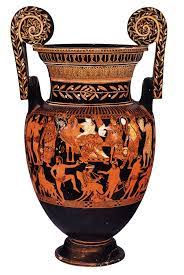
Which mythological figures are present on the Pronomos Painter volute krater, and why?
Dionysus and Ariadne - Dionysus is the God of theatre, and Ariadne is his wife.
2
New cards
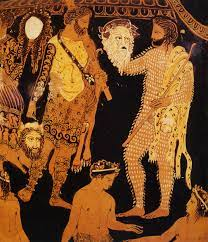
What is significant about these figures?
They are holding masks, proving the existence of masks in Greek theatre, and what they look like. They are slightly bigger than the actors‘ heads with pronounced facial expressions.
3
New cards

Who is the figure on the left, how can we tell, and why is he important?
Demetrios, a playwright. We can tell because he is holding a scroll. His presence shows that this is a scene from real life, rather than a play, and that the celebration is probably of his victory at the Dionysia or other competition.
4
New cards
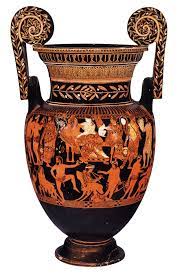
What is the provenance of the Pronomos Painter vase, and why is this important?
Southern Italy. This shows that greek theatre had spread to colonies in Magna Graecia, signifying its cultural significance to Greek identity.
5
New cards
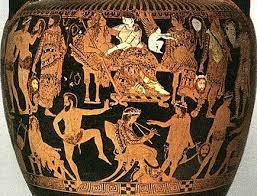
What does the writing next to figures tell us?
The real-life names of the figures depicted.
6
New cards

Who is this?
Promonos, an aulos player and one of the most famous musicians of Ancient Athens
7
New cards
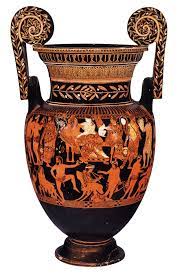
What kind of play is being prepared for here, and how can we tell?
A satyr play. We can tell because there are chorus members dressed as satyrs.
8
New cards
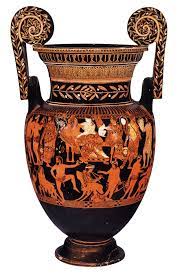
What is a krater?
A mixing bowl.
9
New cards
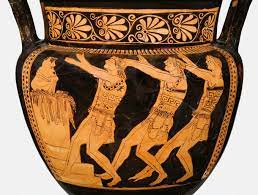
Who is the figure on the left?
Unclear - could be Dionysus, or could be a ghost. In ‘The Persians’ (Aeschylus), there is a ghost. This would align with the military costumes of the chorus.
10
New cards

What does the Basel Dancers vase show?
A tragic chorus performing barefoot in a choreographed formation in military dress.
11
New cards
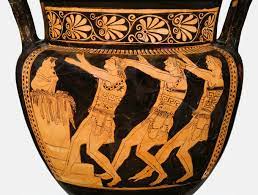
What style is this vase painted in?
Mannerist
12
New cards
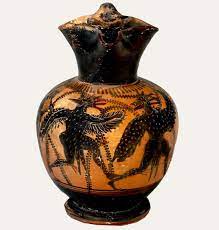
When was the Birds Oinochoe painted, and why is this significant?
c.480 BC, which predates Aristophanes’ ‘The Birds’, which was written in 414. This shows that comic choregoi dressed as animals before Aristophanes was writing.
13
New cards
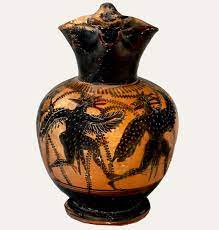
What is an oinochoe?
A wine jug.
14
New cards
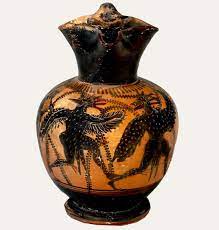
How do we know this is a depiction of a comic chorus, not mythological creatures?
The beards of the actors are visible, and the marks on their arms and wings are demonstrative of a feathered costume. There is also an aulos player on the left, suggesting that this is a tragic chorus with musical accompaniment.
15
New cards
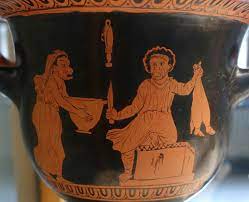
Which play does this vase depict a scene from?
Aristophanes’ ‘Women at Thesmophoria, or ‘*Thesmophoriazusae*’.
16
New cards
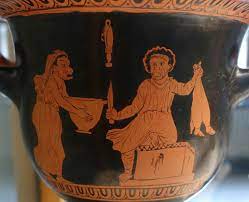
What is ‘Women at Thesmophoria’ about?
It parodies Euripides’ negative presentation of women. Euripides convinces an older male relative to infiltrate the all-female Thesmophoria festival. However, the women discover him, and the relative snatches a ‘baby’ as hostage from onw pf the women. Upon closer inspection, he realises that it is not a baby, but a wineskin with boots on. The women who was holding the wineskin worries that she will lose the wine, so grabs a bowl to catch the wine in if he stabs it.
17
New cards
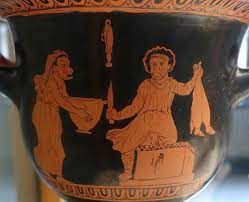
What stereotype of women is presented in the play, and in this vase?
Women as scheming alcoholics.
18
New cards
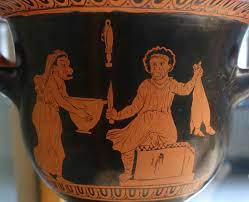
What is the figure on the right standing on?
A sacrificial altar, which is completely tonally inappropriate and adds to the comedy.
19
New cards
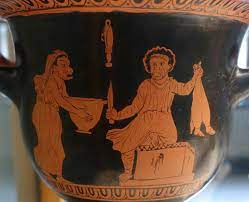
What is the provenance of this vase, and why is it significant?
It is from south Italy, which proves that theatre had spread to the edges of Greek culture. Furthermore, the ‘Thesmophoriazusae’ references Euripides and his plays, which means the audience would have been familiar with tragedy and theatre as a whole, rather than this being a phenomenon.
20
New cards
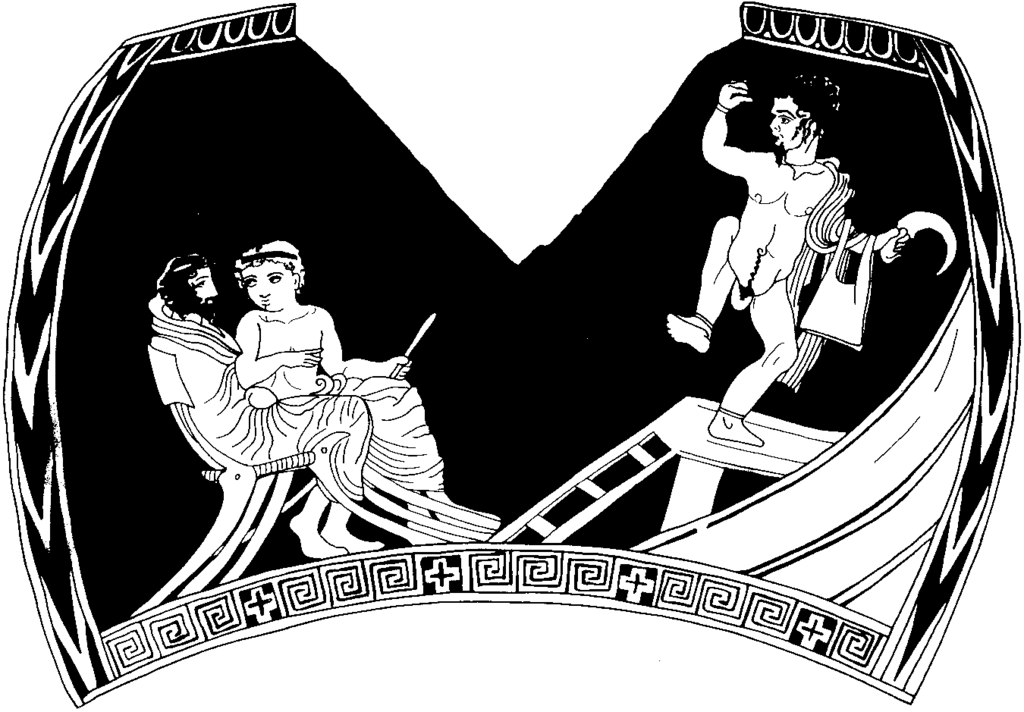
Which mythological character is the figure on the right potraying, and how do we know?
Perseus; he had a sickle, and his bag probably contains Medusa’s head.
21
New cards
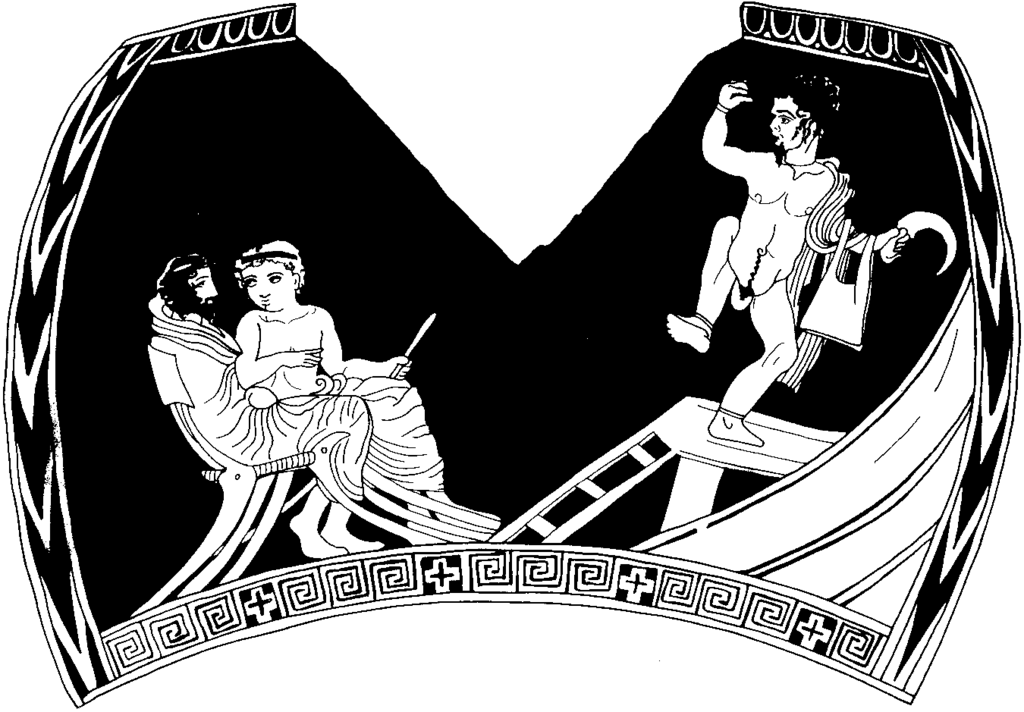
Who are the figures on the left?
The bearded one is probably an important audience member or the playwright himself. They are obviously a private audience, because they are seated on wooden chairs, rather than stone seating. Perhaps this is a rehearsal? The unbearded one is probably a sexual partner of the other’s. He is probably the eromenos, and this depicts a pederastic relationship.
22
New cards
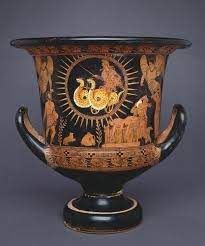
Which play does this depict a scene from?
Euripides’ ‘Medea’.
23
New cards
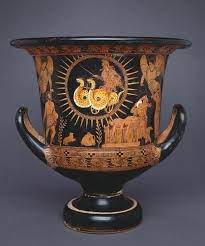
Who is the figure on the left, and how do we know?
Jason - he is in the hero’s pose and locking eyes with Medea
24
New cards
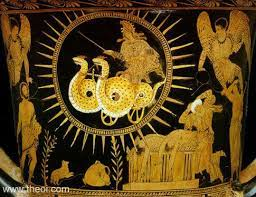
Why is this vase significant in what it tells us about theatre?
It shows the use of the crane in a play.
25
New cards
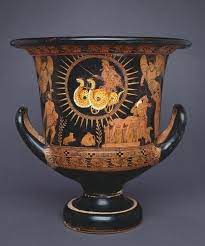
How does the scene depicted here differ from the version in Euripides’ play?
The children’s bodies are slumped over the altar here, whereas in the play, Medea brought them with her in the chariot so that Jason would be unable to bury them. There are also harpies present, where there wouldn’t be in the original.
26
New cards
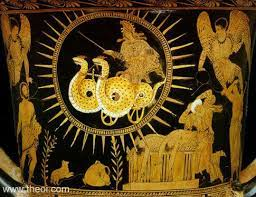
How does the painter increase the drama of this scene?
Medea is framed by the sun, and is locking eyes with Jason. The harpies also help draw attention to the severity of the crime.
27
New cards
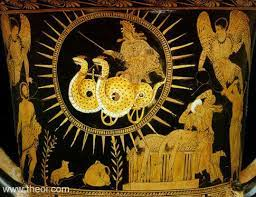
Who is the figure on the right, and how do we know?
The tutor, identifiable by his white hair.
28
New cards
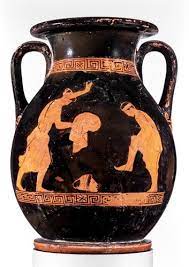
What does this vase show, and why is it significant?
It shows actors dressing for a play. This is significant because it shows us parts of the costumes they would have worn, e.g. boots, cloaks and masks. The vase also clearly shows men dressed as women, evidencing the fact that there were no female actors.
29
New cards
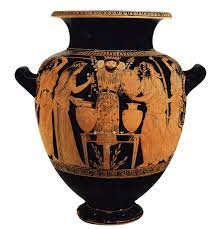
Who is the figure in the centre, and how can we tell?
A statue of Dionysus. He is on the table and is wearing a crown, surrounded by vines.
30
New cards
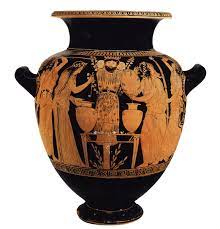
What is the maenad on Dionysus’ immediate right doing?
Playing the tambourine.
31
New cards
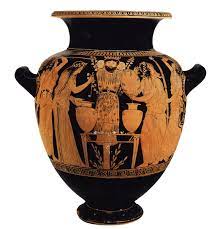
How are the women identifiable as maenads?
They have long, untethered hair and crowns made of vines. Some are also carrying thrusus, and one appears to be serving wine from two jars.
32
New cards
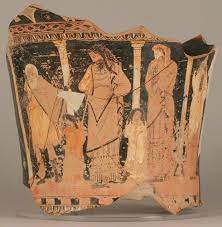
A scene from which play is depicted on this vase?
Oedipus the King
33
New cards
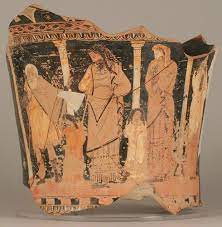
How can we tell that this vase depicts a play, and not the myth itself?
The figures appear to be wearing masks, and we can see the stage and the pillars of the skene
34
New cards
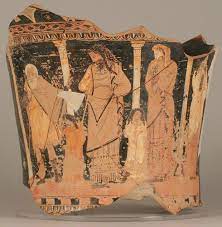
Who are the smaller figures?
Oedipus and Jocasta’s children, Ismene and Antigone
35
New cards
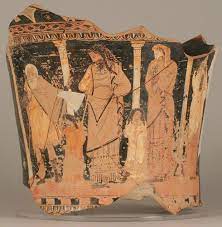
Who is the figure on the left?
The messenger
36
New cards

Who is the figure in the middle?
Oedipus
37
New cards
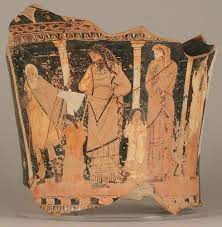
Who is the figure on the right, and why us she clutching her face?
Jocasta; because she has just realised who Oedipus is.
38
New cards
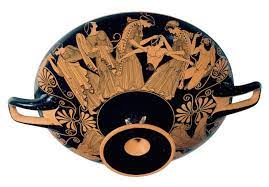
What is a kylix?
A drinking cup
39
New cards
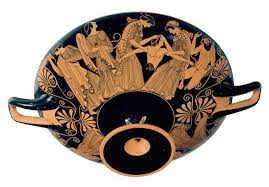
What mythological scene does this vase painting depict?
The death of Pentheus.
40
New cards
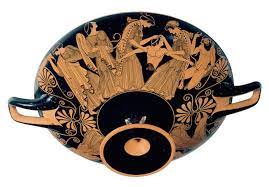
Why is this vase important to our understanding of Bacchic myths, and the story of Pentheus?
It predates the Bacchae, proving that this was a populat=r myth before Euripides dramatised it.
41
New cards
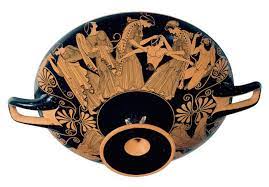
Who is the male figure on the far right, and what does he represent?
A satyr, symbolising Dionysus. This is what makes the scene recognisable as the death of Pentheus. and no just any old dismemberment,
42
New cards
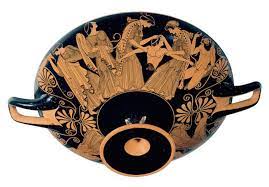
How does Euripides make Pentheus’ death even more humiliating?
He dresses him as a woman.
43
New cards
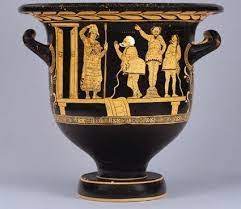
Who is the figure on the left, and how does he differ from the others depicted?
Aegisthus, the lover of Clytemnestra. He is a character from Agamemnon, and is killed by Orestes. He differs from the others because he is in tragic dress.
44
New cards
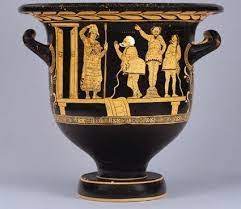
How is the figure on the right identifiable as a tragic figure, rather than a comic one?
He has a stylised costume, a serious expression and laced up kothornoi.
45
New cards
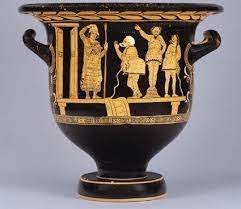
How are the figures on the right identifiable as comic actors?
They have grotesque masks, oddly padded costumes and overexaggerated genitals.
46
New cards
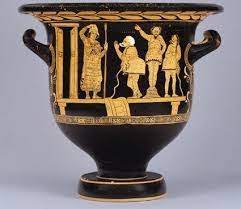
Who is the figure standing on the stool?
Pyrrhias, an Ateolian general.
47
New cards
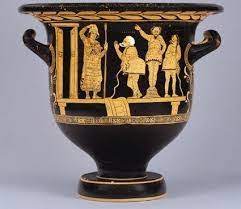
The figures on the right are labelled ‘κωρηγος’ (*choregos*). What does this suggest about the importance of the comic chorus?
That it was an instrumental part of comic theatre.
48
New cards
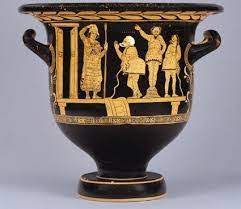
What makes this scene recognisable as a piece of theatre?
A stage is visible, along with the doors to the skene. The actors are clearly costumed and wearing masks. The fact that the figures on the right are labelled as the chorus cements this.
49
New cards
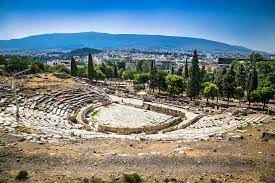
What is the seating area of the theatre called?
The theatron
50
New cards
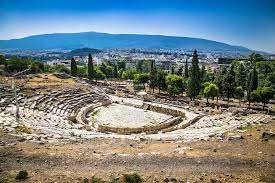
Why are the archaeological remains of the Greek theatres we have today not illustrative of their original appearance?
Many theatres would have been made of wood, and not been given stone until later on. Furthermore, the theatron would most likely have been extended with wooden seating to fit more people in.
51
New cards
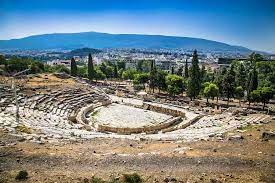
Why are the seats in the front row fancier than the others?
Because they were for important visitors, like judges, politicians and the priest of Dionysus.
52
New cards

What would sit on the altar at the front of the theatre?
A wooden statue of Dionysus.
53
New cards
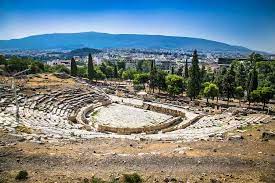
What was the pit before the stage called?
The orchestra.
54
New cards
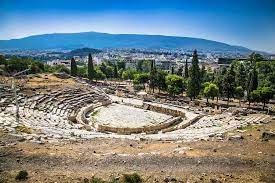
What was the raised stage area called?
The proskene
55
New cards
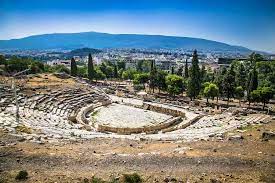
What was the building behind the stage called, where the actors would go to change?
The skene.
56
New cards
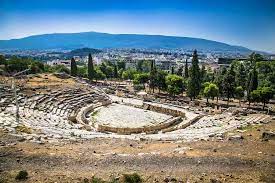
What were the entrances either side of the orchestra called, where the chorus would enter?
The Parados
57
New cards
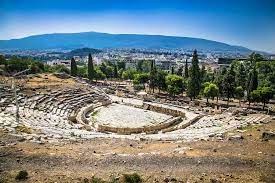
What is significant about the Theatre of Dionysus?
It is the main Athenian theatre, and where the City Dionysia would be held.
58
New cards
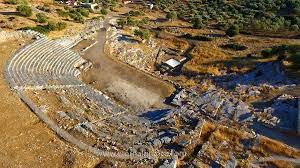
What is significant about the theatre of Thorikos?
It was part of a coastal deme, proving that theatre was popular outside the big cities.